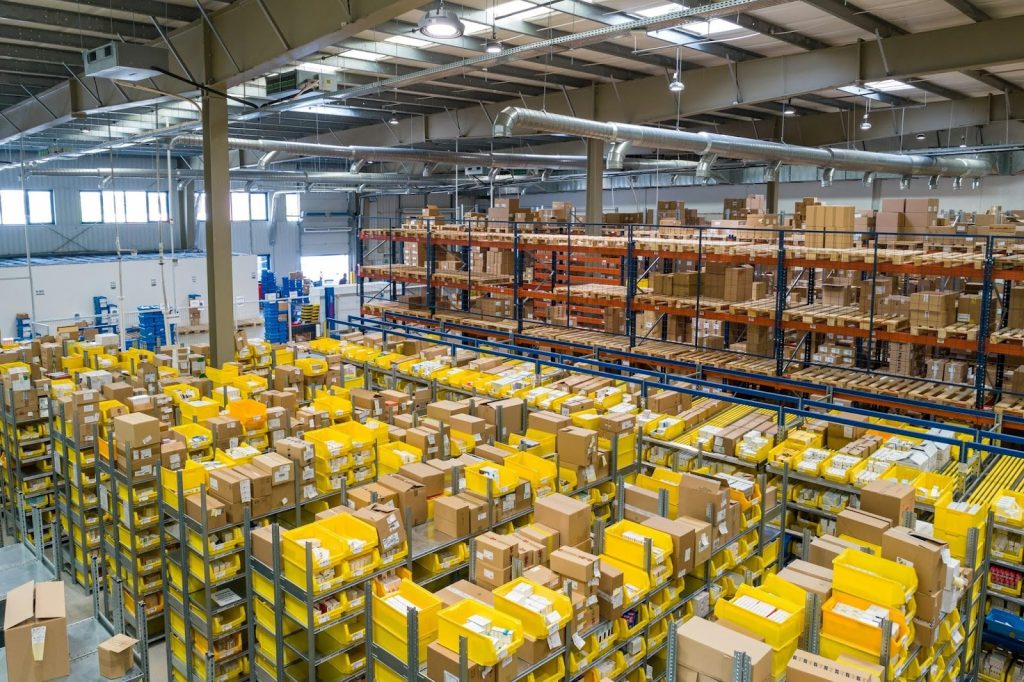In the fast-paced world of logistics and supply chain management, optimizing warehouse space is crucial for businesses aiming to enhance productivity, reduce costs, and improve overall efficiency. With the rise of e-commerce and consumer expectations for swift deliveries, effective warehouse space management has become more important than ever. In this blog post, we’ll delve into various tips and tricks to help businesses make the most of their warehouse space.

Maximizing Warehouse Efficiency
Pallet racking systems are integral components of modern warehouse infrastructure, designed to maximize storage space and optimize inventory management. These systems consist of upright frames and horizontal beams, providing sturdy support for palletized goods, professionals from https://www.thematerialhandler.com/pallet-racking/ explain. By utilizing vertical space effectively, pallet racking systems enable businesses to store large quantities of inventory while maintaining easy accessibility for picking and retrieval. With various configurations available, such as selective, drive-in, or push-back racking, businesses can customize their systems to suit specific storage needs and space constraints. Pallet racking systems enhance operational efficiency by facilitating organized storage, streamlined workflows, and improved inventory control. Their versatility and scalability make them essential assets for businesses seeking to optimize warehouse space utilization and enhance overall productivity.
The Importance of Warehouse Space Management
Warehousing is the cornerstone of the supply chain, functioning as a central node for storing inventory, fulfilling orders, and distributing goods. Effective warehouse space management is essential for achieving optimal performance across various facets of business operations. By maximizing warehouse space, businesses can realize significant benefits in several key areas:
Cost Reduction: Efficient space management enables businesses to make the most out of their existing warehouse footprint, minimizing the need for additional space and associated costs. By avoiding the expense of renting or owning larger facilities, businesses can allocate resources more effectively, leading to substantial cost savings.
Improved Workflow: A well-organized warehouse layout promotes efficient movement of goods and personnel, facilitating smoother operations. By reducing clutter and optimizing storage configurations, businesses can minimize delays and bottlenecks, ultimately enhancing order processing times and customer satisfaction.
Enhanced Inventory Control: Proper space utilization enhances inventory visibility and accessibility, allowing businesses to maintain tighter control over their stock levels. By avoiding stockouts or overstock situations, businesses can optimize inventory turnover rates and reduce the risk of obsolete inventory, thereby improving overall profitability.
Tips for Efficient Warehouse Space Management
Conduct Regular Audits and Inventory Assessments
To initiate efficient warehouse space management, begin by conducting thorough assessments of your current inventory and storage configuration. Implement regular audits to pinpoint any slow-moving or obsolete items that could be occupying valuable space unnecessarily. Leverage advanced inventory management software to maintain precise tracking of stock levels and analyze demand trends meticulously.
This data-driven approach enables businesses to make informed decisions about inventory placement and storage allocation, ensuring optimal space utilization and facilitating seamless operations within the warehouse environment. By continuously monitoring and adjusting inventory strategies based on real-time insights, businesses can streamline processes, minimize waste, and maximize the efficiency of their warehouse space management practices.
Implement Vertical Storage Solutions
Maximize vertical space by utilizing tall shelving units, mezzanines, or pallet racking systems. Vertical storage solutions help to optimize floor space while providing easy access to inventory. Consider implementing automated storage and retrieval systems (AS/RS) for high-density storage and efficient retrieval of goods.
Utilize Space Optimization Techniques
Employ space-saving techniques such as cross-docking, which involves transferring goods directly from inbound to outbound shipments without storing them in the warehouse. Additionally, adopt slotting techniques to strategically place fast-moving items closer to shipping areas for quicker access.
Adopt Lean Warehouse Practices
Embracing lean warehouse practices is essential for boosting efficiency and minimizing waste. By strategically organizing workstations, businesses can streamline the process of picking, packing, and shipping goods, aligning operations with lean principles. Prioritize the elimination of unnecessary movements and the optimization of workflows to reduce cycle times and enhance overall productivity. Implementing lean methodologies empowers businesses to operate more effectively, delivering products to customers faster and with greater accuracy. Regularly assess and refine processes to maintain a lean mindset and drive continuous improvement throughout the warehouse environment. With a commitment to lean principles, businesses can optimize their warehouse operations, reduce costs, and improve customer satisfaction.
Invest in Technology and Automation
Embrace technology and automation to enhance warehouse efficiency. Implement barcode scanning, RFID systems, and warehouse management software (WMS) to track inventory in real time and improve accuracy. Explore automation solutions such as conveyor systems, robotic picking, and automated guided vehicles (AGVs) to streamline operations and reduce labor costs.
Utilize Temporary Storage Solutions
Consider utilizing temporary storage solutions such as mobile shelving units or stackable containers during peak seasons or when experiencing fluctuations in inventory levels. These flexible storage options allow businesses to adapt quickly to changing demands without committing to permanent expansions.
Optimize Packing and Shipping Processes
Efficient packing and shipping processes are crucial for minimizing waste and enhancing cost-effectiveness. Businesses should focus on utilizing standardized packaging sizes to maximize container utilization and minimize wasted space. By adopting cubing software, companies can accurately calculate the most efficient packing configurations for each shipment, reducing void spaces and optimizing transportation costs.
Additionally, integrating automated systems for packing and labeling can further streamline operations and improve accuracy. Continuous evaluation and refinement of packing processes based on data insights can help businesses achieve greater efficiency and customer satisfaction while reducing environmental impact through the reduction of packaging materials.
Collaborate with Suppliers and Partners
Collaborate with suppliers and logistics partners to streamline inbound processes and reduce lead times. Explore vendor-managed inventory (VMI) arrangements or consignment stock agreements to minimize inventory holding costs and improve supply chain visibility.
Continuously Monitor and Adapt
Continuous monitoring and adaptation are critical aspects of effective warehouse space management. Businesses should regularly track key performance indicators (KPIs) like inventory turnover rates, fill rates, and storage density to gauge the efficiency of their space utilization. Leveraging data analytics enables businesses to pinpoint areas for improvement and identify trends that may impact warehouse operations. By analyzing this data, companies can develop proactive optimization strategies to address evolving business needs and market dynamics.
Whether adjusting storage layouts, implementing new technologies, or optimizing workflows, a commitment to continuous improvement ensures that warehouse operations remain agile and responsive to changing demands. Embracing a culture of ongoing monitoring and adaptation empowers businesses to stay competitive and maintain peak efficiency in their warehouse operations.

Efficient warehouse space management is essential for maximizing productivity, reducing costs, and maintaining a competitive edge in today’s dynamic market landscape. By implementing the tips and tricks outlined in this post, businesses can optimize their warehouse space utilization and achieve greater operational efficiency. From conducting regular audits to embracing technology and automation, strategic space management practices can drive significant improvements across the supply chain. By prioritizing efficiency and innovation, businesses can effectively navigate the challenges of warehouse space management and position themselves for long-term success.

